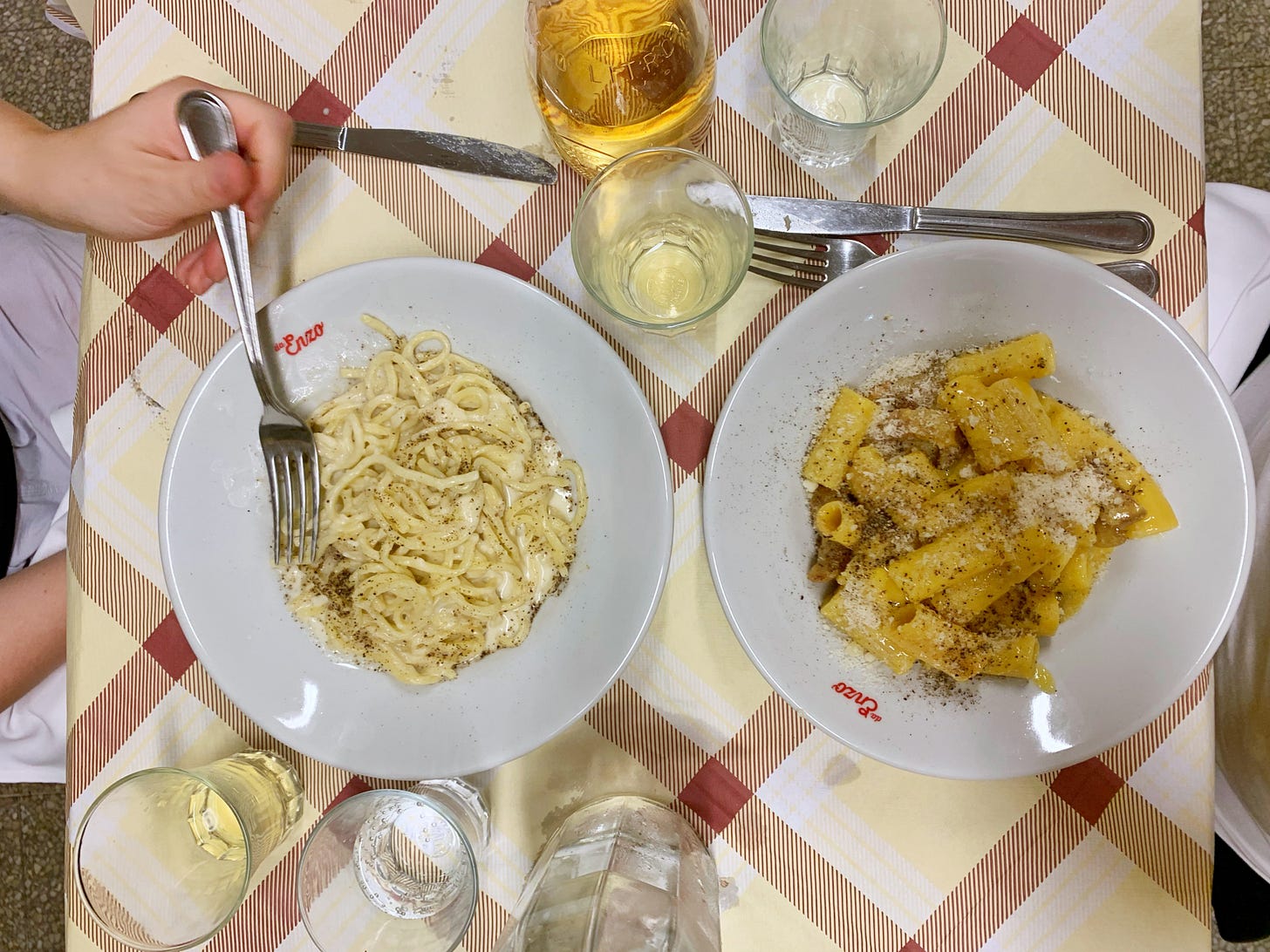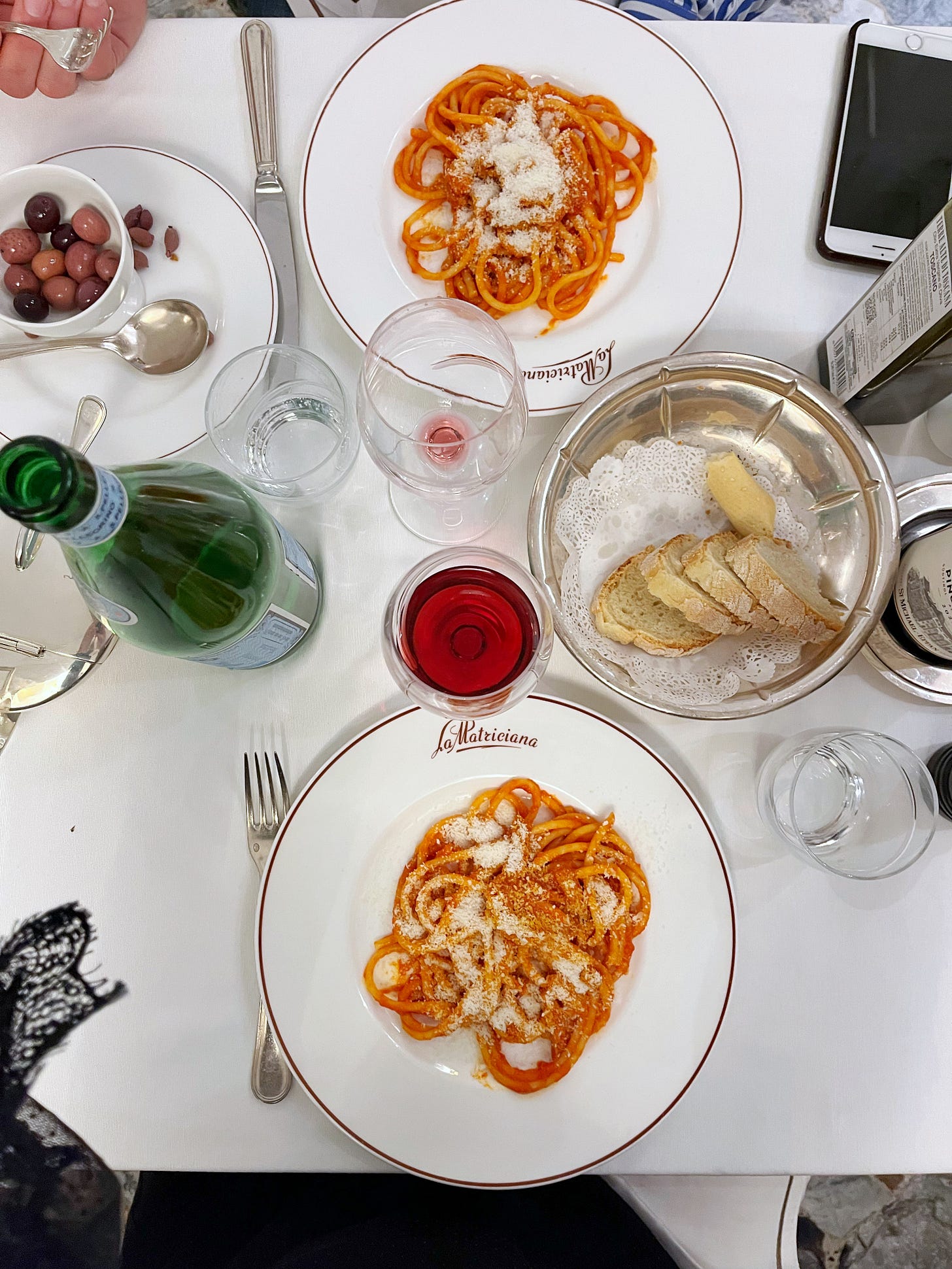If you’ve traveled around Italy at all, you’ve likely noticed that the food is intensely regional. With the exception of dishes like spaghetti al pomodoro and tiramisù, you’ll find Tuscan food in Tuscany, Sicilian food in Sicily, Ligurian food in Liguria, and so on and so forth. Generally speaking, you shouldn’t expect to find lasagna, pesto genovese, or eggplant parmigiana on menus in Rome. In my opinion, this is one of the joys of traveling around Italy—everywhere you go, there are different regional specialties to taste.
The Roman culinary tradition is one of Italy’s many cucina povera (i.e. poor cuisine) traditions, so dishes tend to be made using just a few humble ingredients that were readily available in and around Rome. Back when the most iconic Roman dishes were created, the most common cheese was pecorino romano—a hard, salty sheep’s milk cheese—so most Roman pastas use pecorino romano instead of Parmigiano Reggiano, which comes from Parma. And while the quartet of Roman pastas can be enjoyed year-round, vegetable-based dishes are very seasonal.
So what are the dishes you should be ordering in Rome? Read on to learn about the ubiquitous dishes on Roman menus, the sweet treat you might not know to order, and some notes on the offal you should be aware of (but might want to skip).
Antipasti
At typical Roman trattorias, antipasti could be a cheese and meat board with local charcuterie, cooked vegetables, or fritti (fried foods).
Supplì
Supplì are the Roman cousins of Sicilian arancini. They’re smaller and shaped like ovals instead of perfect spheres, but like arancini they’re fried balls of rice with a breadcrumb crust. The classic version features rice cooked in tomato sauce with a gooey mozzarella center, but you’ll find many other creative versions, sometimes made with pasta instead of rice. They’re commonly eaten as an appetizer at pizzerias, but you can also find them at friggitorie (places that specialize in fried foods) and sometimes trattorias.
Artichokes
Artichoke season is winter through early spring, so if you see artichokes on menus in the summer, be aware that they’re frozen, not fresh. In Rome, there are two classic preparations: carciofi alla romana and carciofi alla giudea. Carciofi alla romana are stuffed with garlic and mentuccia (wild mint) and braised until they become soft and tender. Carciofi alla giudea are artichokes originating in the Roman Jewish tradition whose leaves are smashed open and fried twice so they become extra crispy.
Fiori di zucca
Zucchini blossoms are another seasonal delicacy, available in the spring and summer, after the artichokes have disappeared. I love pizza with zucchini blossoms, anchovies and mozzarella. I also love fiori di zucca in pastela, often served in pizzerias as an appetizer. The zucchini blossoms are stuffed with mozzarella and anchovies, battered, and fried.
Primi
A primo (the plural is primi) is the first course, which usually consists of pasta, rice, or soup. At Roman trattorias, you’ll usually find the quartet of Roman pastas (cacio e pepe, carbonara, amatriciana, and la gricia), but you’ll often see other primi that might be house recipes or seasonal specialties.
Cacio e pepe
This pasta is about as simple as it gets—the sauce is made with pecorino romano and freshly cracked black pepper that’s been emulsified and transformed into a bowl of creamy, salty goodness. It’s ubiquitous in Roman trattorias, where it’s sometimes the only vegetarian pasta on the menu. I’m partial to the one at Da Enzo al 29, where they use fresh tonnarelli, but every Roman has their favorite.
Carbonara
This iconic Roman dish is made using guanciale (crispy pork cheek), pecorino romano, freshly cracked black pepper, and eggs that are beaten and tossed onto the pasta raw so they gently cook with the heat of the pasta but don’t scramble. Legend has it the recipe was invented during the Second World War when some American soldiers gave their army ration of eggs and bacon to an Italian chef and he used them to make pasta.
Keep reading with a 7-day free trial
Subscribe to The New Roman Times to keep reading this post and get 7 days of free access to the full post archives.







